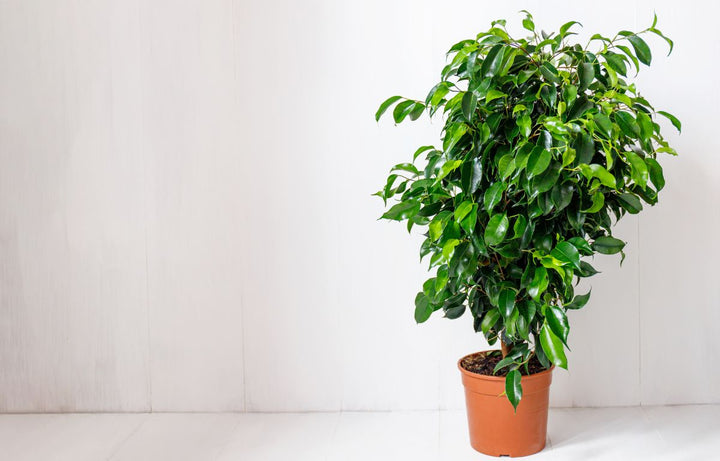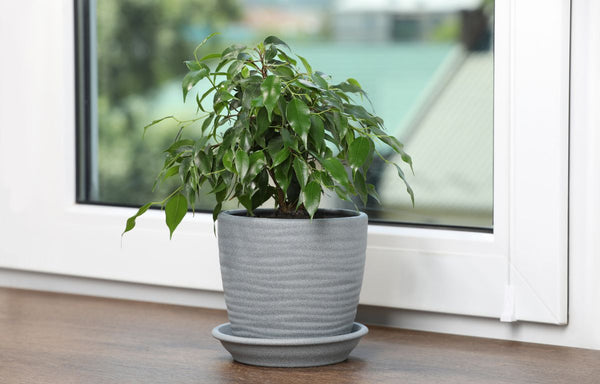
Plant Profile: Weeping Fig
Plant Profile: Weeping Fig
In the realm of indoor plants, the Weeping Fig, scientifically known as Ficus benjamina, stands as an emblem of elegance and tranquillity. With its gracefully arching branches and glossy green leaves, this botanical beauty has charmed plant enthusiasts for centuries. Originating from the tropical regions of Asia and Australia, the Weeping Fig has a rich history intertwined with mythology and cultural significance.

Origin and Cultural Significance
The Weeping Fig boasts a heritage that stretches back thousands of years. Native to Southeast Asia and parts of Australia, it has been revered in various cultures for its symbolic and practical value. In Hindu mythology, the tree is associated with the god Vishnu and is believed to represent the interconnectedness of all living beings. Additionally, it holds significance in Buddhism, where it is often planted near temples as a symbol of enlightenment and spiritual growth.
Throughout history, the Weeping Fig has been cultivated for its many practical uses as well. Its flexible branches have been utilized in basket weaving, while its latex sap has been employed for medicinal purposes. Today, it is primarily cherished for its ornamental beauty and air-purifying qualities, making it a popular choice for indoor plant collections and domestic landscaping.
Care and Maintenance
While the Weeping Fig exudes an air of sophistication, caring for it doesn't have to be complicated. With the right approach, you can ensure that your plant thrives and graces your space with its verdant charm.
Light: Weeping Figs thrive in bright, indirect light. Place your plant near a window where it can receive ample sunlight without being exposed to direct rays, which can scorch its leaves.
Temperature: Maintain a consistent temperature range of 18-24°C for optimal growth. Avoid placing the plant near drafty areas or heating vents, as sudden temperature fluctuations can stress the plant.
Watering: Keep the soil consistently moist but not waterlogged. Water your Weeping Fig when the top inch of soil feels dry to the touch, typically every 1-2 weeks. Ensure proper drainage to prevent waterlogging, which can lead to root rot.
Humidity: Weeping Figs thrive in humid environments. Increase humidity levels by misting the leaves regularly or placing a tray of pebbles filled with water beneath the plant.
Fertiliser: For optimal growth, fertilise your Weeping Fig with a balanced houseplant fertiliser during the growing season. Choose a water-soluble fertiliser formulated for indoor plants, and apply it according to the manufacturer's instructions to provide essential nutrients for healthy foliage and growth.
Pruning: Regular pruning helps maintain the Weeping Fig's elegant shape and promotes healthy growth. Trim away any dead or yellowing leaves and prune back leggy branches to encourage bushier growth.
Repotting: Weeping figs have an extensive root system, so it's essential to provide enough room for them to spread out. However, they prefer to be slightly root-bound, meaning they don't need an excessively large pot. A container that is about 5cm wider in diameter than the root ball is generally sufficient.
Repot your Weeping Fig every 2-3 years or when it outgrows its current container. Choose a pot with adequate drainage holes and a well-draining potting mix rich in organic matter.

Problems and Solutions
Growing a Weeping Fig (Ficus benjamina) as a houseplant can be rewarding, but it also comes with its fair share of challenges. Here are some common problems you might encounter and solutions to help you keep your weeping fig healthy and thriving:
Leaf Drop: Weeping Figs are notorious for dropping leaves, especially when they undergo environmental changes or stress. This can be due to factors like underwatering, overwatering, sudden temperature fluctuations, or low humidity. Maintain consistent watering habits, ensuring that the soil remains evenly moist but not waterlogged. Avoid placing the plant near drafty areas or heating vents, which can cause stress. Increasing humidity levels through misting or using a humidifier can also help prevent excessive leaf drop.
Yellowing Leaves: Yellowing leaves can indicate a variety of issues with your Weeping Fig, including overwatering, underwatering, poor drainage, or nutrient deficiencies. Check the moisture level of the soil and adjust your watering frequency accordingly. Ensure that the pot has proper drainage to prevent waterlogging. If the soil is consistently wet, allow it to dry out slightly between waterings. Consider fertilising your Weeping Fig with a balanced houseplant fertiliser to address nutrient deficiencies.
Pests: Weeping Figs are susceptible to pests such as spider mites, mealybugs, scale insects, and aphids, which can infest the leaves and stems, causing damage and stress to the plant. Regularly inspect your Weeping Fig for signs of pests, including webs, sticky residue, or visible insects. If detected, treat the infestation promptly using insecticidal soap, neem oil, or horticultural oil, following the manufacturer's instructions. For severe infestations, you may need to repeat the treatment several times.
Root Rot: Overwatering or poor drainage can lead to root rot, which manifests as wilting, yellowing leaves, and a foul odor emanating from the soil. Ensure that your Weeping Fig is planted in a well-draining potting mix and that the pot has drainage holes. Allow the top inch of soil to dry out before watering, and always empty excess water from the saucer beneath the pot. If root rot is suspected, gently remove the plant from its pot, trim away any rotted roots, and repot it in fresh, well-draining soil.
Poor Growth: If your Weeping Fig is not growing or appears stunted, it may be due to inadequate light, nutrient deficiencies, or root-bound conditions. Ensure that your Weeping Fig receives bright, indirect light for several hours a day. Consider supplementing with a grow light if natural light is limited. Fertilise the plant regularly with a balanced houseplant fertiliser during the growing season. If the roots are tightly bound in the pot, consider repotting into a slightly larger container to provide more room for growth.
The Weeping Fig stands as a testament to the enduring allure of nature's creations. With its graceful form and rich cultural heritage, it serves as a reminder of the profound connection between humanity and the natural world. By understanding its origins and providing proper care, we can cultivate an environment where the Weeping Fig can thrive, enriching our lives with its beauty and symbolism for generations to come.
